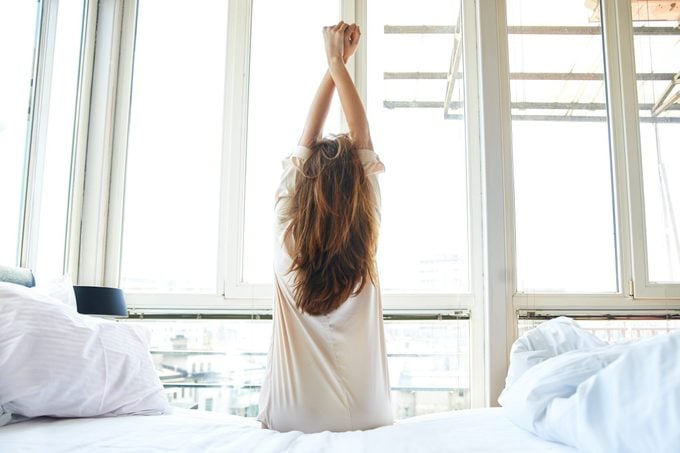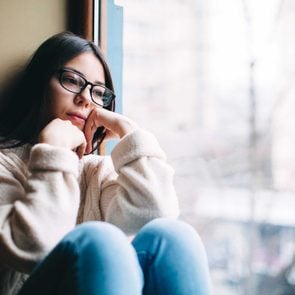The 7 Best Sunrise Alarm Clocks for Seasonal Affective Disorder, From Shoppers
Updated: Mar. 07, 2022
Seasonal depression affects a reported 25 percent of us—but also, who couldn't use some support to sleep better? To help regulate your sleep and wake up to brighter days, find which of these sunrise alarm clocks could be just right for your room.
Our editors and experts handpick every product we feature. We may earn a commission from your purchases.
More than just the winter blues?
From colder, gray weather to holiday stress and nightfall before dinner’s even on the table, most of us know the winter months can get gloomy. Seasonal depression might feel isolating, but it’s rather common: In 2021, a team of biomedicine and physiology researchers in Germany suggested 25 percent of Americans experience a form of depression that’s commonly known as seasonal affective disorder (SAD).
Janine Ilsley, an integrative therapist with Cobb Psychotherapy, says individuals with seasonal affective disorder may experience sadness, irritability, difficulty concentration, and changes in their sleep or appetite when the winter months set in. Often, by spring, these sad symptoms will suddenly subside. “The primary way to distinguish [seasonal affective disorder] from its more clinical counterpart, Major Depressive Disorder (MDD), is through the degree and duration of its symptoms, as well as the patterns by which it presents throughout the months,” this therapist explains. “SAD is more unique in its timing, and transitory in nature.”
The American Psychiatric Association suggests seasonal affective disorder may be a response to how the lack of natural light in winter months affects the balance of chemicals in the brain. When they’re functioning in brighter weather, these chemicals can better work together to regulate mood, energy, decision-making, and even appetite.
Light therapy—the use of a light box that simulates natural sunlight—is one method that’s trending as a way to fend off seasonal affective disorder symptoms. (For the curious, we’ve got background on light box therapy.) Meanwhile, other forms of light therapy are growing in popularity among the winter-weary masses. One of those is the sunrise alarm clock.
Sunrise alarm clocks to fight seasonal affective disorder
Sunrise alarm clocks are similar to the concept of a light box. A sunrise alarm mimics the way the sun wakes you up, no matter the time of day or year. When you set a time to wake up, the clock starts to brighten about 30 minutes prior.
This gradual lighting helps prepare the body to wake up by triggering the release of cortisol, explains Laurie Singer, a licensed psychotherapist and board-certified behavior analyst. “In people with normal circadian rhythms, cortisol levels rise during the early morning hours and then drop very low at night prior to sleep and during sleep,” she says. “So, when the sunrise alarm clock begins to light up, our bodies will start to release cortisol—just like it would with the sun.”
Ilsley says that’s why sunrise clocks may be a beneficial alternative to traditional alarm clocks for everyone—not just people experiencing the winter blues.

What to look for in a sunrise clock
The best sunrise clock for you depends on how much light your body needs to kick-start its wake-up process. As an example, Singer says, “Heavy sleepers might be better served by a brighter, longer-lasting light.”
Other features are largely based on personal preference—but each can make a difference based on what you’re looking for in your sleep routine.
1. A sunset feature
Just as the clock mimicking sunrise signals your body to wake up, some models come with a sunset setting to help you wind down at night, Cavallaro says.
2. Light adjustment
If you’re sensitive to light, Ilsley recommends you look for models that allow you to adjust the brightness (called “lux levels”). Many allow you to use the clock as an all-purpose bedside light as well, set to your preferred brightness level at any time of day.
3. Natural sounds and melodies
“When individuals are jolted out of bed by artificial, jarring sounds, it sends the body into a natural flight-or-flight mode,” Ilsey says. A study published in PLOS One backs this up. Researchers found that sleep sounds and soothing melodies “warm our brains up” for the day and may help reduce levels of morning grogginess.
4. Smart features
Some sunrise clocks go the extra mile, using smart features and apps to help you build morning or bedtime routines and promote better sleep hygiene.
“We recommend a sunrise clock that comes with a guided meditation feature as well as a fully personalized sleep and wake schedule through the app,” says psychologist Aniko Dunn, PsyD at EZCare Clinic.
The best sunrise alarm clocks for SAD
Whether you’re looking to keep your circadian rhythm in check or want a gentler start to your day than a blaring alarm, check out these expert-recommended sunrise clocks.

Philips SmartSleep Wake-Up Light HF3520/60
$99
This top-rated sunrise clock has a warm, red-tinted light that gradually brightens to white daylight, closely mimicking a sunrise. The soothing Philips bulb also works in reverse to simulate sunsets—and for either time of day, there are 20 brightness setting options.
“I personally use the [Philips SmartSleep Wake-Up Light], and I love it,” Cavallaro says. “I feel much more refreshed in the morning when using it.”
She says you can also pair the light with gentle alarm sounds, like birds chirping or a gentle flute sound.

Hatch Restore
$129
The Hatch Restore is more than an alarm clock—the device aims to be your total sleep assistant. This functionality starts with its bedtime routine setting, which allows for 10 unique, customized steps. You can program (and set timeframes for) options like a reading lamp, white noise, light colors, meditations, and sleep stories.
While the Hatch Restore partners with its own native app, it’s easy to adjust levels like brightness and volume by tapping buttons on the device itself. Then, of course, you can program your own personal sunrise for each morning either by selecting preset “themes” or choosing from the clock’s 22 different color shades.

hOmeLabs Sunrise Alarm
$40
“This is the model I suggest to those on a budget or just curious to see if [a sunrise clock] will work for them,” Singer says. “[It] comes with most of the bells and whistles of higher-priced models.”
It has a warm LED light that starts brightening 30 minutes before your set alarm and a selection of nature-inspired sounds to wake up to (as well as a standard FM radio alarm setting).
The clock also comes with eight lids you can clip on—in tones like purple, red, or blue—whether you want a more colorful wake-up call or to change your lighting throughout the day.

Lumie Bodyclock Luxe 750DAB
$270
Singer points to Lumie’s sunrise clocks for those seeking a model with plenty of customization potential.
You can set daily or weekly alarms configured to your exact preference of light brightness and duration—the Lumie’s sunrise or sunset can extend for up to 90 minutes. The light itself transitions between true-to-nature pinks, reds, ambers, oranges, and brilliant, rise-and-shine white.
There’s also a low-blue light setting, which Lumie’s researchers say signals your body to kick-start melatonin production as you wind-down for bed. The Luxe 750DAB also comes with a companion app and USB charging port.
It also functions as a bedside lamp with seven color light options and 20 brightness levels.

Jall Sunrise Alarm Clock
$40
This no-frills dawn simulator lets you program two separate alarms (as well as a 9-minute snooze function if you need a slow rise on those cold winter mornings.) Its sunrise light brightens from 10 to 100 percent over your choice of 10, 20, or 30 minutes. There are also seven alarm sounds to accompany your personal sunrise, ranging from piano music to ocean waves or a classic wake-up beep.
It’s a great budget option that also functions as a bedside lamp with seven color lights options and 20 brightness levels.

LittleHippo Mella Ready to Rise Children’s Sleep Trainer
$50
This clock could help your kids form healthy sleep habits. It sports a fun design with lights, colors, and facial expressions that aim to develop a bedtime and morning routine for your child, teaching them when it’s time for sleep and time to get up. One Amazon reviewer said the colors helped her special needs child reach a more reliable sleeping pattern: “This way the clock would not only promote her staying asleep or in bed at night, but help her maintain a schedule during the day,” the reviewer said. She added that the locking buttons make this a great clock for very small or some special needs children.
The device also includes additional features like a sound machine, night light, and nap timers.

LIFX LED Smart Lights
$50
If you already have a bedroom lamp you love—or no room for a bedside device—these color-changing smart bulbs are a great way to create your own DIY sunrise alarm clock. Just keep in mind that if you’re not sure if you’ll wake up to light alone, you’ll need a secondary sound-based alarm.
The bulb is voice compatible with smart home systems like Alexa, Apple HomeKit, Siri, and Hey, Google. All you do is screw in the bulb, choose your preferred app, and program your own sunrise and sunset. The company claims there are 550 billion color possibilities and an enormous, customizable brightness range.
Other ways to treat seasonal affective disorder symptoms
Even with all these sunrise alarm clock options, many of our experts make a worthwhile point: While dawn simulators or sunrise alarm clocks can be a great tool for anyone’s sleep hygiene, they’re not a cure for SAD. If you’re having difficulty managing SAD symptoms, talk to your doctor to explore additional seasonal affective disorder treatments, like:
- The light therapy lamps we referred to
- Talk therapy like cognitive behavioral therapy (CBT)
- Antidepressants like SSRIs, which can help regulate serotonin imbalances in people with SAD
- Lifestyle changes like building a morning routine and ensuring you’re getting proper nutrition
(Here are some other little ways to avoid seasonal affective disorder.)















